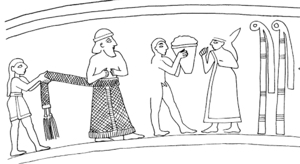Naked Males
Notes: Game on...on the radio...Angels and Rays...top of second...Angels with runners on second and third...Angels 2-0...Trout's double, Ohtani single, and another hit by? scored the two runs in first...Regnifo K...oh, 'Fletcher at the plate'...0-2 count...comebacker to mound throw out...Trout up...intentional walk...and, now Ohtani up...0-1...bases loaded...0-2...1-2...2-2...3-2...W!...Ohtani's at bat against a top pitcher...Pujols up...0-1...0-2...K...to bottom of second...Angels 3-0...so, a quote from yesterday, a curio:
quote
In the art of Mesopotamia the motif appears very early, usually with a "naked hero", for example at Uruk in the Uruk period (c. 4000 to 3100 BC), but was "outmoded in Mesopotamia by the seventh century BC".[13]
https://en.wikipedia.org/wiki/Master_of_Animals
unquote
and too from yesterday was this:
quote

http://potnia.theladyofthelabyrinth.com/symbols-of-the-minoan-goddess-religion/
unquote
I've often seen that, a ring I think...and then this, which I've pondered more than I should admit!...Rays made out...to top of third...
quote

https://www.amazon.com/White-Goddess-Historical-Grammar-Classics/dp/0374289336/ref=asc_df_0374289336/?tag=hyprod-20&linkCode=df0&hvadid=312178241251&hvpos=1o1&hvnetw=g&hvrand=6535662367986916461&hvpone=&hvptwo=&hvqmt=&hvdev=c&hvdvcmdl=&hvlocint=&hvlocphy=9031590&hvtargid=pla-526333454308&psc=1&tag=&ref=&adgrpid=60258871577&hvpone=&hvptwo=&hvadid=312178241251&hvpos=1o1&hvnetw=g&hvrand=6535662367986916461&hvqmt=&hvdev=c&hvdvcmdl=&hvlocint=&hvlocphy=9031590&hvtargid=pla-526333454308
unquote
that ring Graves captions...and, I cant find it...Angels made out...to bottom of third...lol...in 2015 I left a comment, and poem, at amazon's page-- the poem:
To Her, To You
In the cities' world
I had no one to pray to,
No one to wish to,
For good luck and your answer yes
When I called on the telephone asking you to be with me awhile.
So, I found my own goddess of love,
Of the sun and the moon and the earth, everything,
And prayed to her, to you,
My eyes lowerd
Offering the gift I had to give,
To her, to you.
DavidDavid
(I'm from California, and was there in '69)
Oh, the little guy on the book's cover inspired that poem..:)
unquote (me)
I'm not adverse to dropping poems in venues strange to them!...lol...anyway, then there is this:
quote
The band above the sheep is a blank and might have featured painted decoration that has since faded away. Above this blank band, a group of nine identical men march to the left. Each holds a vessel in front of his face, and which appear to contain the products of the Mesopotamian agricultural system: fruits, grains, wine, and mead. The men are all naked and muscular and, like the sheep beneath them, are closely and evenly grouped, creating a sense of rhythmic activity. Nude figures in Ancient Near Eastern art are meant to be understood as humble and low status, so we can assume that these men are servants or slaves (the band above, displays the slave owners).
... ... ...
The top band of the vase is the largest, most complex, and least straightforward. It has suffered some damage but enough remains that the scene can be read. The center of the scene appears to depict a man and a woman who face each other. A smaller naked male stands between them holding a container of what looks like agricultural produce which he offers to the woman. The woman, identified as such by her robe and long hair, at one point had an elaborate crown on her head (this piece was broken off and repaired in antiquity).
Behind her are two reed bundles, symbols of the goddess Inanna, whom, it is assumed, the woman represents.

https://smarthistory.org/warka-vase/
unquote
wait, Angels up...Fletcher up...Tover on first...weird bounce off second base...base hit!...Rays' pitcher Snell replaced...Snell won the Cy Young award last year...it's top of fourth...Trout up...W...bases loaded again for Ohtani!...1-0...2-0...2-1...2-2...rbi fielder's choice...Rays first baseman dropped the ball...'just drops it'...Albert up...Angels 4-0...and, the 'two reed bundles' are a curio...K...to bottom of fourth...the bundles for tomorrowmorrow!...foray out for snack, and watch the game...update: parking lots full, returned to listen to game, and, when Angels fell behind Rays 9-4 in the seventh and eighth, took a nap...I dont keep regular hours!...anyway, after some searching, I sourced the illustration on Graves' book above...it's modern, made to look old...here's a good take:
Quote
Thomas Yaeger's Blog: Decoding Robert Graves
http://shrineinthesea.blogspot.com/2015/04/decoding-robert-graves.html
In a letter to T.S. Eliot concerning the publication of The White Goddess, Graves writes:
"I have asked Creative Age to send you the cover design of The White Goddess, done by Kenneth Gay with me standing over him all the time. It shows the goddess Carmenta giving Palaimedes [sic] the eye which enables him to understand the flight of the cranes which originated the alphabet."
... ... ...
Graves then breaks up the myth into a sequence of images, in the manner he suggests in his introduction to The Greek Myths. The first of these images is the basis for the White Goddess sigil:
... ... ...
"...a naked young man cautiously approaching three shrouded women of whom the central one presents him with an eye and a tooth; the other two point upwards to three cranes flying in a V-formation from right to left." [WG p230] In his analysis of the myth of the Lamia [GM 61.1], Graves suggests that her removable eyes "are perhaps deduced from a picture of the goddess about to bestow mystic sight on a hero by proffering him an eye." It is likely that the presence of the pentagram in the picture signifies the special kind of insight granted to the hero Palamedes.
... ... ...
The provenance of the sigil is entirely a product of Graves method: as far as I am aware there is no antique exemplar of this image. Nor would I expect one to turn up. Graves has reconstructed a ritual image on the basis of an interesting, but highly idiosyncratic interpretative method and analysis. But, it should be remembered, The White Goddess is about the grammar of poetry and myth, not ancient history. Graves is exploring a pattern of thought, not describing the past.
unquote
well, 'pattern of thought', sorta...Graves was a blabbermouth, spillar of secrets, gossip extrodinaire...before twitter he tweeted, and continues ghostly...
:)
DavidDavid








No comments:
Post a Comment